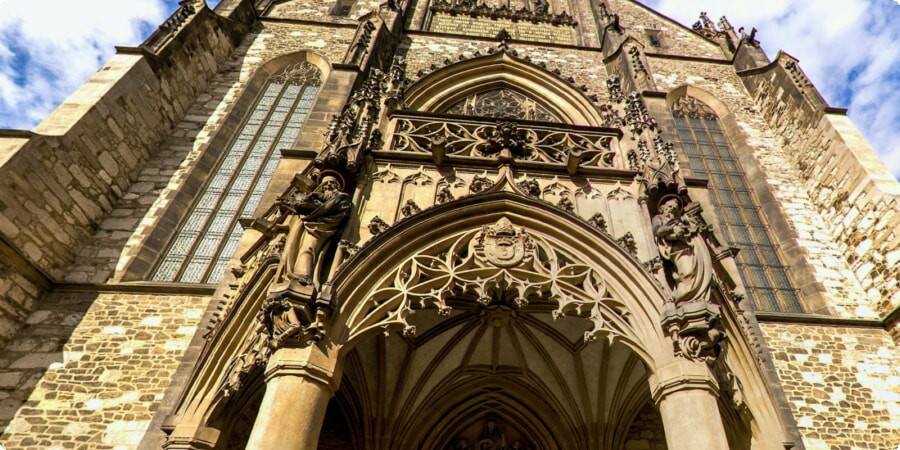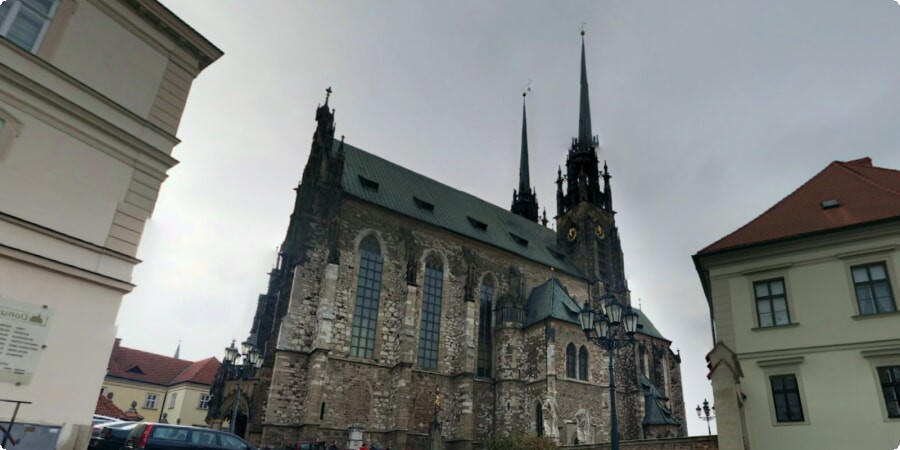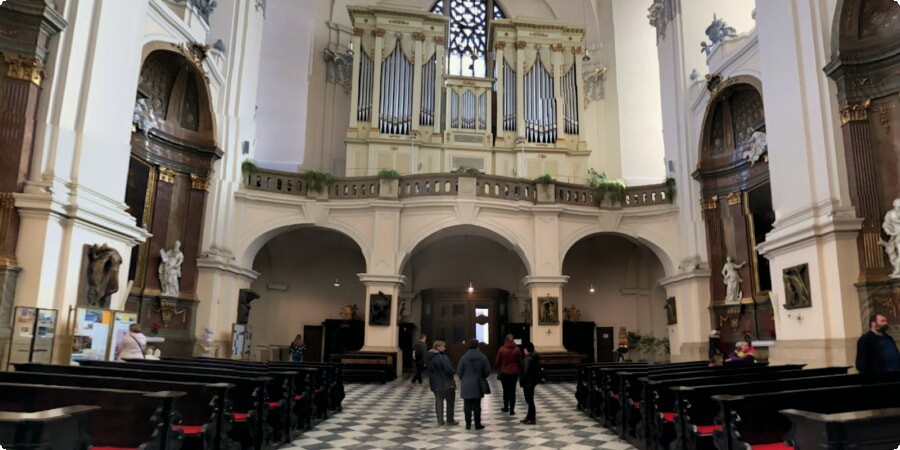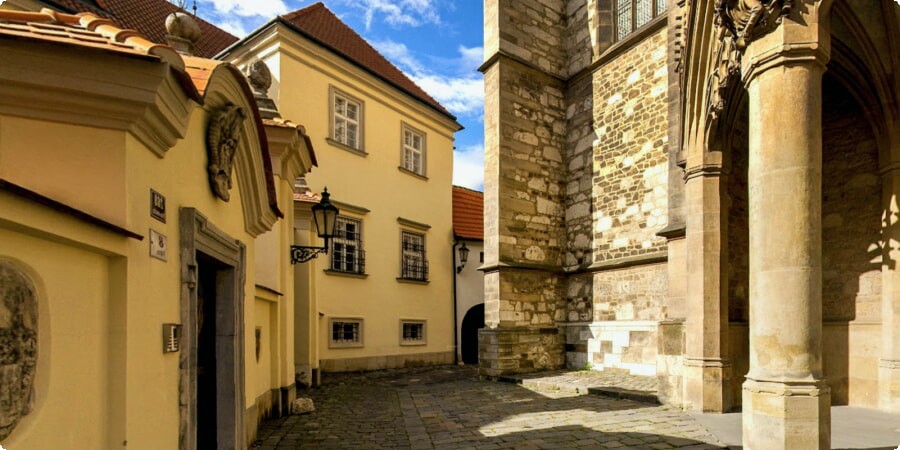Perched majestically on Petrov Hill, the Cathedral of St. Peter and Paul dominates Brno's skyline, its twin spires reaching for the heavens. This iconic structure is not just a centerpiece of the city’s silhouette but also a symbol of Brno’s rich cultural and religious heritage. Known for its striking Gothic architecture, the cathedral is a must-see for anyone visiting Brno, offering a glimpse into the city’s past and a connection to its spiritual roots.
The cathedral’s influence extends beyond its physical presence. It has played a central role in the life of Brno for centuries, witnessing countless historical events and evolving alongside the city. As you stand before its grand facade, it’s impossible not to feel a sense of awe at the sheer scale and beauty of the structure. But this awe is only the beginning. To truly appreciate the cathedral, one must delve into its history, explore its architectural nuances, and understand the stories and legends that have woven themselves into its very stones.
The Historical Foundations: From Romanesque Beginnings
Long before the Gothic spires of St. Peter and Paul Cathedral pierced the sky, the site on Petrov Hill held a different, yet equally significant, structure. The history of this sacred site dates back to the 11th century when a Romanesque basilica first stood here. This early church was a symbol of Brno’s growing importance as a center of power and religion in Moravia. As the city expanded and its influence grew, so too did the need for a larger, more imposing place of worship.
The transformation from a Romanesque basilica to the Gothic cathedral we see today was neither swift nor straightforward. It began in the 13th century, during a period of architectural revival across Europe, when Gothic styles were becoming the preferred expression of ecclesiastical power and devotion. The decision to rebuild the church in the Gothic style was a reflection of Brno’s aspirations, as the city sought to align itself with the grandeur of other European cultural centers.
Over the centuries, the cathedral’s construction and expansion were influenced by various historical events. The Hussite Wars, the Thirty Years' War, and the siege of Brno during the Swedish invasion all left their marks on the cathedral, with each event leading to periods of destruction, rebuilding, and modification. Despite these challenges, the cathedral remained a constant in the life of Brno, evolving with the city and its people.
To explore the cathedral’s evolution further, you can visit its location on Google Maps and imagine how it might have looked as a simple Romanesque church before its transformation into the Gothic masterpiece we see today.

Architectural Evolution: From Gothic Roots to Modern Restoration
The architectural journey of the Cathedral of St. Peter and Paul is a testament to the enduring appeal of Gothic design, as well as the adaptability of the structure to various artistic influences over the centuries. The cathedral’s most striking features, its twin spires, are a relatively modern addition, completed in the early 20th century. These spires, soaring 84 meters high, were added during a period of neo-Gothic restoration, which sought to emphasize the original Gothic elements of the structure.
The core of the cathedral, however, dates back to the 14th century, when the Gothic reconstruction was in full swing. The pointed arches, ribbed vaults, and large windows filled with intricate stained glass are all hallmarks of Gothic architecture, designed to inspire awe and elevate the soul. The interior, with its high ceilings and dramatic play of light and shadow, creates an atmosphere that is both grand and contemplative.
But the cathedral’s architectural story doesn’t end with the Gothic period. The Baroque era left its mark as well, particularly in the chapels and altars, which were adorned with elaborate decorations typical of the time. This blend of Gothic and Baroque styles gives the cathedral a unique character, reflecting the various phases of its development.
In the late 19th and early 20th centuries, as part of a broader movement to preserve and celebrate Gothic architecture, the cathedral underwent significant restoration. This period of restoration not only reinforced the structural integrity of the building but also restored many of its original Gothic features, which had been altered or obscured over the centuries. The result is a cathedral that, while modern in some respects, remains true to its Gothic roots.
If you’re planning to explore the architectural beauty of the cathedral, it’s worth considering a road trip to Brno. For convenience and flexibility, you might want to book a car in Prague through Travelocars and drive down to Brno, enjoying the scenic Czech countryside along the way.

Exploring the Cathedral: A Tour of Key Features
As you step inside the Cathedral of St. Peter and Paul, you are immediately struck by the sense of grandeur and reverence that permeates the space. The cathedral is not just an architectural marvel; it’s a living, breathing testament to centuries of faith and artistry. Each corner, each alcove, tells a story, and a self-guided tour allows you to experience this history firsthand.
One of the first features you’ll notice is the impressive high altar, a centerpiece of religious and artistic significance. This Baroque masterpiece is adorned with intricate carvings and statues that depict scenes from the life of Saints Peter and Paul, to whom the cathedral is dedicated. The altar is a focal point for worship and draws the eye upward, reinforcing the Gothic intent to lift the spirit towards the divine.
The cathedral’s stained glass windows are another highlight, bathing the interior in a kaleidoscope of colors. These windows, many of which date back to the 19th century, depict various biblical scenes and saints, their vivid imagery telling stories of faith and sacrifice. As the sunlight filters through, it creates a serene and almost ethereal atmosphere within the cathedral, inviting quiet contemplation.
Don’t miss the chance to explore the chapels that line the sides of the nave. Each chapel has its own unique character, often reflecting the time period in which it was constructed or renovated. The Chapel of the Holy Sepulchre, for instance, is a beautiful example of Baroque art, with its richly decorated altar and detailed frescoes.
For those interested in the cathedral’s historical artifacts, the treasury offers a fascinating glimpse into the past. Here, you’ll find a collection of liturgical objects, vestments, and religious art that spans several centuries. These items, many of which are still used in ceremonies today, provide a tangible connection to the cathedral’s long history.
As you explore the cathedral, you’ll find that each visit reveals something new. Whether it’s the play of light through the stained glass, the quiet beauty of the chapels, or the grandeur of the high altar, the Cathedral of St. Peter and Paul offers an experience that is both spiritually enriching and aesthetically pleasing.
Legends and Myths: The Mysteries Surrounding the Cathedral
Like many ancient structures, the Cathedral of St. Peter and Paul is surrounded by legends and myths that add to its mystique. These stories, passed down through generations, have become an integral part of the cathedral’s lore, blending history with folklore in a way that captivates both locals and visitors alike.
One of the most famous legends associated with the cathedral is the tale of the Brno Dragon. According to local folklore, a fearsome dragon once terrorized the people of Brno, until a brave knight managed to defeat it using cunning rather than brute force. The dragon’s body was said to be displayed in the city as a warning to others who might challenge Brno’s strength. While the story is likely just a myth, the "dragon" — which is actually a crocodile — can still be seen hanging in the Old Town Hall, not far from the cathedral.
Another intriguing story is that of the cathedral’s bells. Legend has it that during the Swedish siege of Brno in 1645, the city’s defenders tricked the Swedish army into retreating by ringing the noon bells an hour early. Believing they had run out of time to capture the city, the Swedes abandoned the siege. To this day, the cathedral’s bells ring at 11 a.m. instead of noon, commemorating the clever ruse that saved Brno.
These legends, while entertaining, also reflect the cathedral’s deep connection to the history and culture of Brno. They remind us that the cathedral is not just a place of worship, but a symbol of the city’s resilience and ingenuity.
If these stories inspire you to explore more of Brno and the surrounding regions, consider renting a car to make the most of your visit. With a vehicle at your disposal, you can easily visit other historical sites and hidden gems across the Czech Republic. You can book a car through Travelocars to enjoy a convenient and flexible travel experience.

The Cathedral in the Heart of Brno: Cultural and Spiritual Significance
The Cathedral of St. Peter and Paul holds a special place in the heart of Brno, not only as a religious monument but also as a cultural landmark that has shaped the city’s identity. For centuries, it has been a beacon of faith for the people of Brno, serving as the main seat of the diocese and the focal point of numerous religious ceremonies and celebrations.
The cathedral’s influence extends far beyond its religious role. It is deeply embedded in the cultural fabric of Brno, hosting a variety of events that bring the community together. From classical music concerts that fill the nave with beautiful melodies to art exhibitions that highlight the region’s rich artistic heritage, the cathedral is a vibrant cultural hub. These events are not just about entertainment; they are a way for the people of Brno to connect with their history, their faith, and each other.
The cathedral is also a place of pilgrimage, attracting visitors from across the world who come to experience its spiritual atmosphere. Whether they are drawn by the history, the architecture, or the legends, these pilgrims add to the cathedral’s significance as a global landmark. Their presence is a testament to the cathedral’s enduring appeal and its ability to inspire people from all walks of life.
For the residents of Brno, the Cathedral of St. Peter and Paul is more than just a building; it is a symbol of their city’s resilience, creativity, and faith. Its towering spires serve as a constant reminder of Brno’s rich heritage and the enduring spirit of its people. As you explore the cathedral, you’ll come to understand why it has remained such an important part of Brno’s identity for centuries.
Visiting St. Peter and Paul Cathedral: What to Know Before You Go
Visiting the Cathedral of St. Peter and Paul is a rewarding experience that requires some practical planning to fully appreciate all it has to offer. The cathedral is open to visitors throughout the year, with specific hours depending on the season and any scheduled services or events. To make the most of your visit, it’s a good idea to check the cathedral’s official website or contact their information center for the most up-to-date opening hours and any potential restrictions.
When planning your visit, consider taking a guided tour to gain deeper insights into the cathedral’s history and architectural details. Tours often provide fascinating background information and access to areas that might be off-limits to self-guided visitors. Alternatively, if you prefer exploring at your own pace, an audio guide can offer valuable commentary and help you navigate the cathedral’s key features.
The Cathedral of St. Peter and Paul is centrally located in Brno, making it easy to reach from various points in the city. If you’re driving, there are parking options nearby, although it may be easier to use public transportation or explore on foot, especially in the historic center where parking can be limited. For a more flexible travel experience, consider renting a car to explore Brno and its surroundings. You can book a car through Travelocars to ensure you have the freedom to discover more of this beautiful region.
Brno offers a variety of attractions near the cathedral that are worth exploring. From the nearby Špilberk Castle to the vibrant local markets and charming cafes, there is plenty to see and do. Taking a leisurely walk through the city will allow you to soak in the local atmosphere and experience Brno’s unique blend of historical and modern influences.

The View from Above: Climbing the Spires for a Panoramic Brno
The experience of climbing the Cathedral of St. Peter and Paul’s spires is one that offers breathtaking views and a unique perspective on Brno. The spires, standing at an impressive 84 meters, provide panoramic vistas of the city and the surrounding countryside. The climb can be a bit challenging, but the reward of reaching the top is well worth the effort. The views offer an unparalleled opportunity to photograph the cityscape and appreciate the architectural beauty of Brno from above.
As you ascend the spires, you’ll pass through various levels that showcase different aspects of the cathedral’s structure. The observation platform at the top allows for unobstructed views and is a great spot to reflect on the city’s history and the cathedral’s role within it. On clear days, you can see for miles, taking in the picturesque landscape that stretches beyond Brno.
The climb is typically guided, and it’s recommended to wear comfortable shoes and be prepared for some steep stairs. The experience is an unforgettable part of visiting the cathedral and offers a memorable way to connect with Brno’s heritage and the grandeur of its architectural marvel.
Preserving a Legacy: The Ongoing Conservation Efforts
Preserving the Cathedral of St. Peter and Paul is a continuous effort that involves both maintaining its physical structure and ensuring its historical integrity. Ongoing conservation projects aim to address the challenges of preserving such a historic building while accommodating the needs of modern visitors. These efforts include restoring original features, addressing wear and tear, and implementing measures to protect the cathedral from environmental damage.
Community involvement plays a significant role in these preservation efforts. Local organizations, volunteers, and donors contribute to maintaining the cathedral and supporting its various projects. This collective effort ensures that the cathedral remains a vital part of Brno’s cultural and spiritual landscape for future generations.
Visiting the cathedral is not only an opportunity to explore its historical and architectural significance but also to support its preservation. Your visit helps fund ongoing restoration work and supports the cathedral’s role as a center of faith and culture in Brno. By contributing to its preservation, you are helping to safeguard a cherished landmark that continues to inspire and connect people from around the world.
As you plan your visit, remember that the Cathedral of St. Peter and Paul is more than just a building; it is a living testament to Brno’s rich history and vibrant culture. Your experience will be enriched by understanding the ongoing efforts to preserve this magnificent structure and by appreciating the role it plays in the life of the city.
